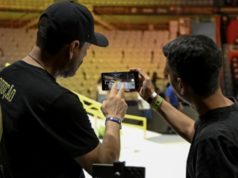Over the last few decades, there have been several attempts to merge the mundane aspects of the real world with the digital. All of these, while catering to a niche, have failed to conquer the world in the way that Mark Zuckerberg hopes that Facebook’s social VR efforts will.
Facebook Spaces was announced at the social network’s F8 conference as a way of blending social media and virtual reality. If you own an Oculus Rift (and Touch controllers), you and four friends can enter a virtual world and hang out together.
Unfortunately, hanging out mostly constitutes of chatting, taking “selfies*” and enjoying the virtual world around you. Oh, and it’s not you, per se, but a cartoon caricature that you control; a dead-eyed digital mannequin that smiles blankly at everyone in the desperate hope that you won’t find it creepy.
Unfortunately, Spaces falls into the same trap that so many other platforms have over the years, assuming that people want the digital world to be a surrogate for the real. And that people have the time and energy to sit around talking to a cartoon with their friend’s voice through thousands of dollars worth of equipment.

Whenever a high-minded tech company makes proclamations about the future of social interaction, I’m reminded of Second Life. Founded more than a decade ago, the title was an open world platform that enabled strangers across the world to come together. It was touted as a digital utopia, a place where you were free to create whatever you wanted, whenever you wanted, however you wanted. Your digital avatar could even fly around the Second Life universe, interacting with people from across the globe.
But in reality, this utopianism was misplaced, and the environment, even during its boom years, was stale and empty. People weren’t all that into into communicating with each other, and the platform gradually became a space for people to develop weird forms of architecture. It became little more than a proto-Minecraft, a gallery space or weird and wonderful designs that few would ever notice. Second Life itself still exists, of course, with around 600,000 monthly active users.
A big part of the internet’s job is to bring people together in ways that we wouldn’t — couldn’t — have conceived a few generations ago. We can now learn so much from people all across the globe and share their experiences, dreams and knowledge. Real-time chat platforms, from IRC to FaceTime, have enabled us to gradually bridge the physical distances that separate us. Still, none are a substitute for real human interaction, face to face, in the real world.
Facebook Spaces, on the other hand, places two more barriers between us and our friends: the bulky VR headset and the digital avatar. Then there are the constraints that Facebook places upon its users. At the moment, Spaces users can’t express sadness or anger. The likelihood of this becoming the new normal for social interactions is about as likely as Disney’s recently shuttered Club Penguin becoming the new Facebook.
[embedded content]
Facebook is asking us to take a chunk of our most precious commodity — our attention — and give it entirely to its virtual world. But that world is one step removed from that of the internet, full of (literally) fake people in a fake place. In the demo video, friends gather together a surprise birthday party to take a selfie of themselves on an imaginary boardwalk.
But where is the reality and authenticity in you, and three other people, taking an image of some cartoon avatars in a virtual world? Will you expect that future historians will unearth these images and marvel at the experiences that you pretended to have?
I wonder if I’m wrong, and that people will embrace this in the same way that they have taking pictures from inside video games. But then that, at least, shows a journey that you’re going on — and an appreciation of a particularly engaging sight that’s been created within the game. Imagine the reaction of your friends and family when you show them your vacation shots from the Grand Canyon that you didn’t visit.
Even Mark Zuckerberg knows that Facebook’s Social VR demo, as it is, not the future of how we’re going to interact with one another. Both this year and last, the CEO showed off a rough idea for an augmented reality platform that could work in a pair of glasses. There, you’d never need to buy a TV, just use the AR overlay in the lenses on conjure one up on the wall of your otherwise sparse living room.
Unfortunately, that idea is nowhere near ready for the real world, and Facebook VP Deb Liu told the AP that the journey to that hardware was “just one percent finished.” Imagine, rather than exchanging time-sucking pleasantries with a cartoon avatar while standing on a fake mountaintop, having someone sitting on your couch next to you.
You’d be able to speak to them as if they were in the room, despite being on the other side of the world. But with this (almost) real interaction, you would have real eye contact, real body language and all of the other things that we, as humans, need in order to feel comfortable interacting with one another.
The software and hardware just isn’t there for this sort of platform, and probably won’t be for a very long time. But that, not Facebook Spaces, is the vision of social VR that I can get behind.
Click here to catch up on the latest news from F8 2017!
* Technically not a selfie, since it’s not the person taking a photo.


![[World Alzheimer’s Day] Samsung Research Advances Early](https://loginby.com/itnews/wp-content/uploads/2025/09/1758375215_World-Alzheimer’s-Day-Samsung-Research-Advances-Early-238x178.jpg)


![[CES 2026] Quest For Perfect Color…Samsung To Push](https://loginby.com/itnews/wp-content/uploads/2025/12/CES-2026-Quest-For-Perfect-Color…Samsung-To-Push-100x75.jpg)

